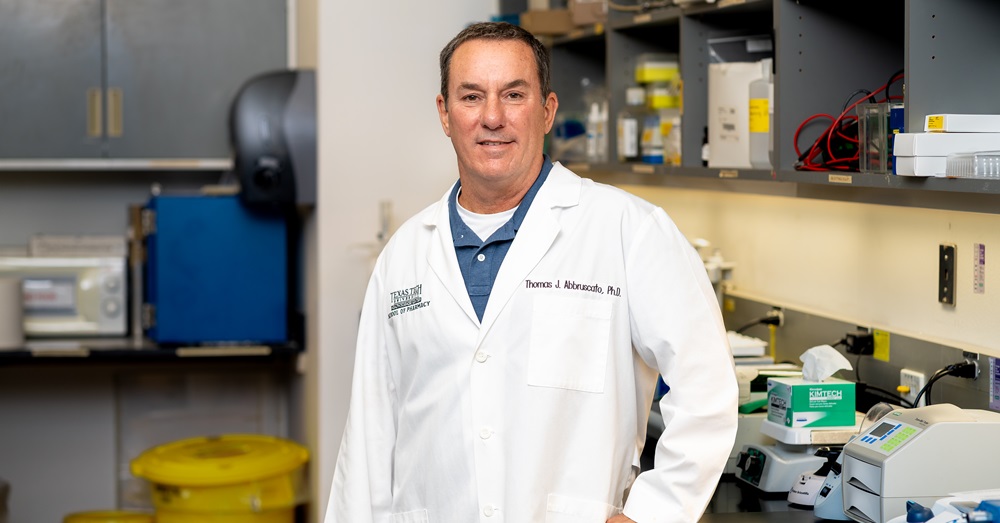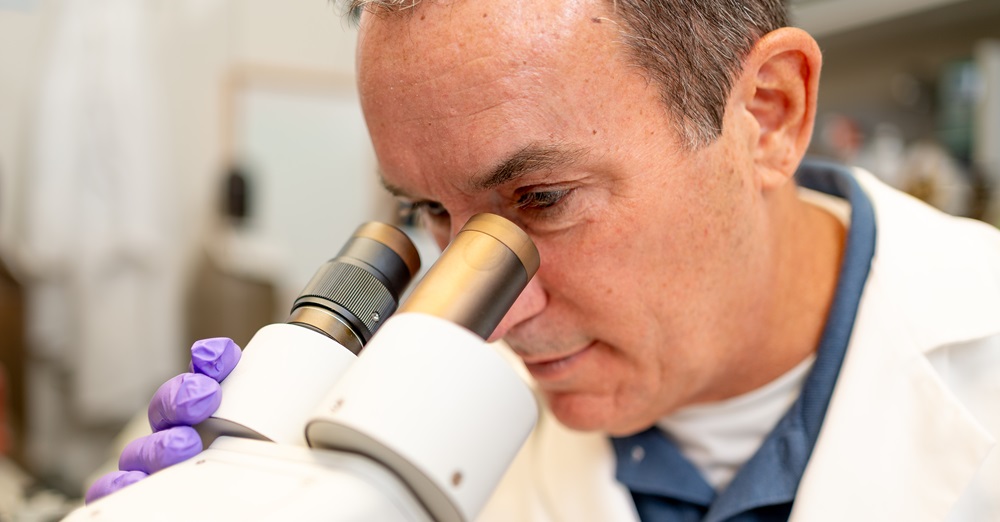Collaborative Team Earns Five-Year Renewal Grant from NINDS to Continue Stroke Research

In 2018 the National Institute of Neurological Disorders and Stroke (NINDS) at the National Institutes of Health (NIH) awarded a five-year, $2.9 million R01 grant (“Development and characterization of peptidomimetic small molecule activators of peptidase neurolysin for stroke therapy”) to a research team from Texas Tech University Health Sciences Center (TTUHSC) in Amarillo to help uncover and develop much needed therapies for the treatment of ischemic stroke. The team for this RO1 project included multiple principal investigators (PIs; project leaders) from TTUHSC’s Department of Pharmaceutical Sciences: Thomas Abbruscato, Ph.D., who serves as department chair and current director of TTUHSC’s Brain Drug Discovery Research Center, Vardan Karamyan, Ph.D., (contact PI) and Paul Trippier, Ph.D.
Because of the COVID-19 pandemic and PIs moving to other institutions (Trippier moved his research group to the University of Nebraska in 2019, and Karamyan moved to Oakland University’s Beaumont School of Medicine in 2022), the team was able to extend the grant from five to seven years. Despite the logistical changes, their collaborative work still produced 29 experimental, conceptual and review publications related to the project and two patents.
Due to this high level of productivity and potential to create new medications for stroke injury, NINDS recently awarded a new $3 million competitive renewal that extends the grant for an additional five years to 2030, something Abbruscato said is often considered more difficult to do than earning the initial grant.

Supported by the new competitive renewal grant, Abbruscato said the team will continue its collaborative efforts to accomplish three well-integrated aims. The first specific aim is to apply medicinal chemistry techniques for lead compound optimization, which will be conducted by Trippier’s lab to further refine the activity and drug-like properties of neurolysin (Nln) activators. In previous research, the team identified Nln as a leading self-protective mechanism in the brain that helps prevent cerebral neuron damage and aids in recovery after stroke.
“This is where we take our lead compounds from Dr. Trippier’s lab that have the best pharmaceutical properties, such as blood-brain barrier penetration, stability and protein binding,” Abbruscato said. “We want to find out if they are stable in the bloodstream and brain, and if they enter into the stroke injury part of the brain. We also look at protein binding, which is very important to make sure there's a free fraction of the compound available to activate the enzyme of interest in the brain. In this case, Nln is the lead enzyme we're trying to activate.”
The project’s second aim is to perform biochemical and structural studies to characterize the activation mechanism(s) targeted by the identified Nln activators. For the biochemical studies, Trippier sends the best candidate compounds to the Karamyan and Abbruscato labs for characterization using in vitro models (outside a living organism, such as using a test tube or culture dish).
“We do an iterative (i.e., computational or mathematical) process where we start with just models,” Abbruscato said. “Dr. Karamyan has a system where you can look at how much the candidate compound activates a pure enzyme. In our lab, we look at blood-brain barrier properties in vitro to find out how these compounds cross the blood-brain barrier and if they are restricted. We’re trying to estimate how much of that new molecule is going to enter into the brain and determine if it truly is at a brain concentration that can activate the enzyme.”
The structural studies related to the project’s second aim will be conducted by co-investigator Benjamin Orlando, Ph.D., from Michigan State University. He will study how Nln and other compound candidates bind to the enzyme.
“These structural experiments were important in our grant renewal because we presented an actual cryo-EM (Cryogenic electron microscopy) image from Dr. Orlando’s laboratory of our target enzyme, Nln, which uncovers the structural components of the enzyme and ligand that are important for activation,” Abbruscato said. “This means we can see exactly which components of the structure are important for activation, and this helps to inform Dr. Trippier in his synthesis of novel compounds.”
The project’s third aim involves characterizing the effectiveness of the drugs in preclinical models of stroke. During this process, the research team will test their best compounds in two models of stroke. Karamyan uses one model known as distal MCAO, a photothrombotic model used to induce a mild ischemic stroke. Abbruscato’s lab will test the same compounds in another model of middle cerebral artery occlusion model, which is a more severe model of stroke.
Abbruscato said using two preclinical models strengthens the study because people can test new molecules in both mild and severe stroke injury models.
“The fact that we're confirming these molecules in two separate labs also makes the work more robust, which was also important in getting the grant renewal,” Abbruscato said. “Our ultimate long-term goal is to translate the lead Nln activators from bench to bedside and ultimately develop an effective stroke therapy, which could transform the current treatment modalities for a vast number of stroke patients.”
Related Stories
TTUHSC Cancer Researcher Honored by National Academy of Inventors
C. Patrick Reynolds, M.D., Ph.D., director of the School of Medicine Pediatric Cancer Research Center at TTUHSC, has dedicated his life as a researcher to developing treatments for childhood cancers.
TTUHSC’s Hudson Set to Serve as President for Society of Clinical Research Associates
The Society of Clinical Research Associates (SOCRA) has elected Texas Tech University Health Sciences Center’s (TTUHSC) Catherine Hudson, Dr.P.H., as its president for 2025-2026.
Clinical Research Institute a Source of Pride for Retiring Griswold
Upon his retirement, John Griswold, M.D., reflects on the Clinical Research Institute and what it has achieved.
Recent Stories
TTUHSC Cancer Researcher Honored by National Academy of Inventors
C. Patrick Reynolds, M.D., Ph.D., director of the School of Medicine Pediatric Cancer Research Center at TTUHSC, has dedicated his life as a researcher to developing treatments for childhood cancers.
TTUHSC School of Nursing Celebrates 10 Years of the Veteran to BSN Program
The TTUHSC School of Nursing recognized the 10-year anniversary of the Veteran to Bachelor of Science in Nursing (VBSN) program during the fall 2025 commencement ceremonies held Dec. 13 in Lubbock, Texas.
TTUHSC Dean to be Inducted into the National Academies of Practice as Distinguished Fellow
Gerard E. Carrino, Ph.D., MPH, dean of the TTUHSC Julia Jones Matthews School of Population and Public Health, will be inducted into the National Academies of Practice (NAP) as a Distinguished Fellow of the Public Health Academy.
